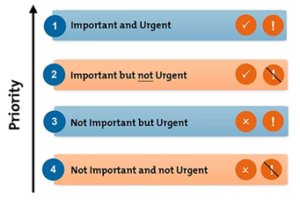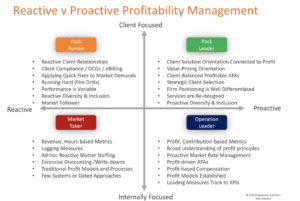As happens in personal life (and certainly with recent headlines), law firm leaders frequently get side-tracked firefighting, acting on urgent tasks that distract from doing important things that will have a more impactful, longer-lasting effect on their firms. It is reacting, not proacting. And this can lead to a firm falling behind its peers and losing its strategic focus.
In what has become known as the Eisenhower Principle,[1] one can view tasks in front of them along two dimensions:
- Important – activities that have an outcome that leads to satisfying our goals,
- Urgent – activities that demand immediate attention, are typically connected to someone else’s goals, but the consequences of not addressing them are immediate.
Eisenhower Principle: Important and Urgent
The Eisenhower Principle combines important and urgent activities into a prioritization framework like that shown below:

The framework emphasizes important items over urgent. Compared to what most people do today, if one were to follow the scheme above, many less important urgent tasks would fall away. This idea is easy to understand in concept but challenging to put into practice.
First, you must be able to classify important and urgent items. And second, you have to be willing to ignore urgent items despite peer pressure, organizational burdens, news flashes, and personal impulse.
Law firm leaders face this dilemma regularly in the quest for change, to introduce new behaviors, and to move firms in new strategic directions. In times of stress, these ideas become even more challenging to maintain. But they become increasingly critical to your success.
Proactive Profitability
Thinking about these ideas from a law firm profitability perspective, I created a two-dimensional grid that places a firm in a profitability performance quadrant. The chart breaks out profit performance along two dimensions: client-centricity and proactiveness.
Its underlying premise is that proactive, client-centric firms will take the required steps to succeed. They surpass the competition by creating stronger relationships with their clients, providing better visibility to the changes necessary to get ahead. Their vision and commitment support the tough sledding required to endure change. They will tackle the important tasks over the urgent.
No firm will possess all characteristics, but the chart places firms into performance zones based on the number of qualities described by each quadrant. Proactive, client-centric firms are located in the upper right quadrant, labeled Pack Leaders.

Pack Leaders interweave profitability principles with client value. They systematically anticipate client needs and act on those opportunities. They differentiate and use profit drivers like pricing to develop relationships. The thing that most distinguishes these firms is coordinated action.
In contrast, at the opposite end of the spectrum, at the bottom left quadrant, are Market Takers. These organizations are highly reactive, with few systematic approaches to profitability. They may possess notions of profit principles but don’t operate in concert with them. They discount without considering value. And their lawyers lack appreciation of profit principles and their connection to firm success. Their perception of profitability is outdated. Commonly their metrics are disconnected from client interests. They are working backward.
Of course, most firms operate somewhere in between those extreme positions. Leaders must face the tough question, assessing their current performance. And this is followed by the more difficult one about where they are heading.
Getting Proactive — Moving to the Upper Right Quadrant
Like most strategic goals, the journey to the upper right quadrant is multi-step, and it may require your team to move outside its traditional comfort zone. It starts by engaging in an honest discussion about your firm’s placement. Here are some recommendations to get the firm moving upward and right on the grid:
- Articulate the “Why.” Explain the underpinnings for the effort, its importance, and your expected result. Go beyond the mechanics and into the foundational principles. Provide a forum for discussion and questions.
- Recognize and Discuss the Difficulty. Explore the underlying causes and the daily urgencies that create distractions from your objectives. Inquire whether there are clear performance targets and if there are proper measures in place to support them. Encourage small steps towards the broader vision. Strive for open and candid discussion.
- Create a Change Support System. Assess your firm’s change posture. Most firms feel like they are less skilled at adapting to change than other businesses. You don’t need to overhaul the firm, but you should create a safe environment to take risks and to reward the learnings associated with trying new things. Use this process to engage clients and to listen carefully to their needs and pain points. Validating ideas with client feedback is a terrific technique to stimulate change.
- Focus on One Important Profit Initiative Each Year. Select projects that will provide you a significant impact in the near term while serving as a launchpad for future steps. Consider the momentum created by each successive level. While any plan will evolve, consider the sequence of steps that will provide the benefits you seek in the time horizon you desire.
- Create Diverse Teams. Ensure you have a diverse team with broad firm stakeholder involvement. You want to cast a wide net for ideas and solutions, creating an inclusive environment. Diversity also builds trust and garners acceptance.
- Design Lead and Lag Metrics. Create and communicate metrics, including lead (e.g., progress tracking indicators) and lag metrics (e.g., end goals). Report these measures widely and share best practices and case studies. Embrace mistakes and share learnings. Create an environment that rewards risk-taking.
- Create an Accountability Loop. Create routine communications and hold participants accountable for communication and hitting performance targets. Provide an open, safe, and trusted operating environment.
- Conduct Campaigns. Avoid program lethargy by stimulating the environment with campaigns, including educational programs, and the sharing of best practices. Create energy and momentum around the initiative.
I invite you to have conversations inside your firm about these ideas and explore your roadmap for next-level profitability. As Peter Drucker said, “the purpose of business is to create a customer.” Profitability will be a natural byproduct that follows.
[1] Named from President Dwight D. Eisenhower’s 1954 speech to the Second Assembly of the World Council of Churches, actually quoting Dr. J Roscoe Miller, President of Northwestern University.
Posted In
